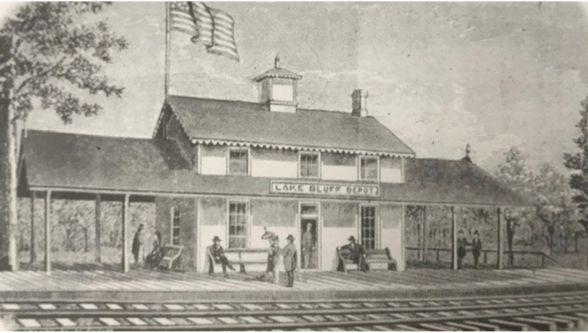Traffic on E. Sheridan Place can back up a bit during weekday mornings and afternoons due to the cars, bikes, scooters and pedestrians heading to and from Lake Bluff Middle School.
But in the late 19th century when Lake Bluff was a summer resort, traffic was caused by a railroad that ran in the middle of the street.
It was built around 1877, two years after the Lake Bluff Camp Meeting Association was founded, and its purpose was to transport summer visitors from Chicago directly to the campground. The train, part of the 1855-built Chicago and Milwaukee Railroad, dropped off travelers at a station house located at the end of E. Sheridan Place and Moffett Road, then called Railroad Avenue and Harris Avenue.
The station house was named Lake Bluff Depot, as you can see in the illustration above. Meanwhile, the main depot on Sheridan Road and Scranton Avenue was known as Rockland, as this area was called before the name changed to Lake Bluff.
The Lake Bluff Depot was a three-minute walk to the Camp Meeting tabernacle on Prospect Avenue, the center of summer activities. We’re guessing the short walk was helpful to women outfitted in the Victorian garb of the era, which comprised a long skirt and petticoat, corset beneath a high-neck blouse with long, poufy sleeves, and tightly laced leather shoes.
Two trains arrived and departed the Lake Bluff Depot every summer day but Sunday, making their exit via a turntable before they headed back to the big city. In the Camp Meeting’s late 19th century heyday, five trains stopped at the Rockland platform on the main line, also dispensing and picking up summer guests.
The Camp Meeting founders were instrumental in getting the spur-line tracks built so close to their grounds, but they soon rued the trains. For one thing, the rattle of metal on metal and the trains’ shrill whistle interrupted Camp Meeting programs on arts, education, religion, and recreation. And their arrival was a major distraction because people would hang out at the depot to see who was getting off the train.
By 1880 the spur line was closed, and the tracks were torn up.
But that wasn’t the end of the depot, which was expanded and transformed into The Fowler Inn, a popular summer venue run by Laura and Albert Fowler, who in 1899 changed the name to Sheridan Inn. The Fowlers advertised the inn as “The only hotel where accommodation may be obtained by wheeling and nutting parties, as well as the public in general.” Wheeling parties accommodated bicyclists. There were two types of nutting parties: one had a nut theme that included food made with nuts, the other invited guests to forage for nuts.
The Sheridan Inn closed in 1920. By then, Lake Bluff had transitioned from its summer vacation roots into a year-round village. The building was abandoned, and it burned down six years later: the last stop for the Lake Bluff Depot.
